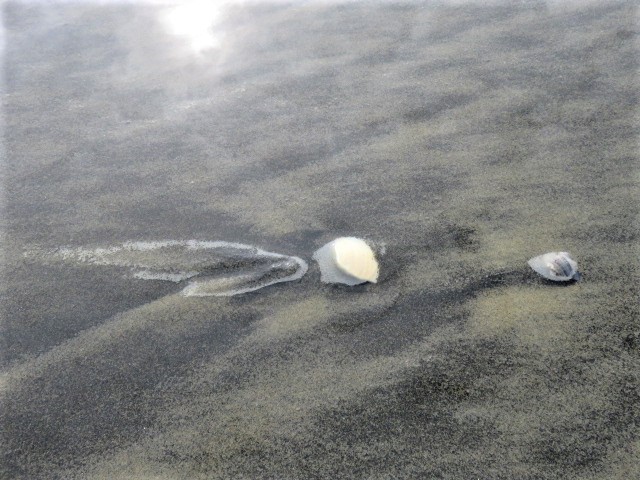Allie took us out to Birthday Beach a few weeks ago. We call it that, although it's really just an northern extention of Muriwai, because we first went to this particular spot on Allie's birthday a few years ago. It's a rough sort of place. The beach is wide and flat and is used extensively by 4 wheel drive trucks and dirt bikes. The speed limit sign on the beach says 60 kph (36 mph), but I've observed that most vehicles pass by at better than 60 mph. I don't think there is much danger of getting hit. The beach is so wide and when we are there, we stay up near the dunes and away from the traffic.
As I walked along the sand that day, I noticed the patterns in it, and I thought I might like to do a post of just sand art. So, here we go.
This next series of pictures reminds me of comets. Think of the shell piece and the patterns in the sand as being in the night sky. Seen against a background of a billion stars at high magnification, the comet's long tails spread out behind them.
This last series of sand art was spotted by Jeanne on Oneroa Beach on our anniversary. I've used various filters to give each its color. I call these pieces Sand Forests.














Oooooo I like these! I noticed the same diamond patterns in your first picture in the sand during my first visit to Bethels Beach in 2014. My youtube channel cover picture features them!
ReplyDeleteIt's interesting how the darker sands separate from the lighter colored ones - makes for really interesting art! I think most people wouldn't even notice it.
I've never seen anything like the 'Sand Forests' you found on Oneroa Beach. I wonder how those were made?
These sand forests were made as the tide was going out. The sand everywhere was slowly drying out and all the water in the beach was moving from the 'tops' of the trees toward the 'bottoms' of the trees.
DeleteI think these 'forest areas' might have had a very slightly greater angle (slope of the beach) from the 'top' of the trees to the 'bottom.' They are like a ripple in the sand. Water moving slightly faster down these slopes carried bits of sand with it at it moved down and the individual tiny streamlets merged, just like larger terrestrial streams and rivers will, eventually all merging to creat the 'trunk' of the tree. These streams deposited the sand they carried in a 'delta,' which is the rounded part at the bottom of each tree. That lighter colored sand around the delta is more level than the browner portion just above it and stopped the sand particles as they rolled along.
That largest brown photo is my favorite. It would look good I think, cropped a bit, blown up and hung on a wall.
How lovely!
ReplyDeleteI think the colored filters added to the appeal.
ReplyDeleteI cannot decide my favorite between the green one and the last one. Gorgeous photos. I learn so much from your blog. McKenzie
ReplyDeleteI'm glad that you liked them.
ReplyDelete